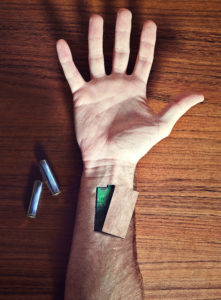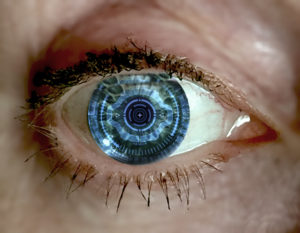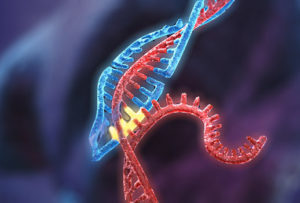I’ve never attended a Meetup like this one before. There were men and women, young and old…oh yeah, and a couple of cyborgs. Well, not really.
 We were there to talk about biohacking. You’re not quite sure what that word means? Before this Meetup, I wasn’t sure either. Throughout the evening, I found myself amazed, excited, confused and occasionally alarmed about where this whole trend might be leading us, as individuals and as a civilization.
We were there to talk about biohacking. You’re not quite sure what that word means? Before this Meetup, I wasn’t sure either. Throughout the evening, I found myself amazed, excited, confused and occasionally alarmed about where this whole trend might be leading us, as individuals and as a civilization.
Biohacking is sometimes referred to as “do-it-yourself body enhancement”. It’s part of a transhumanist body modification movement, which holds to the belief that it is in humanity’s best interests to keep improving our minds and bodies, pushing the boundaries of our physical and mental limitations through the use of science and technology. Biohacking also might make use of medical, nutritional, or physical fitness techniques. It could involve your limbs, your organs, your eyesight, your hearing, your mind or your emotions. And it’s not really a new idea. We can all recall when the South African amputee athlete Oscar Pistorius (who later made the news for other reasons) used metallic spring-like legs to speed across the finish line in Paralympic sprints. For years, bodybuilders and other athletes have been using chemicals to increase their strength and stamina. In 2009 some high level swimmers started wearing “tech swim suits”, which are designed to reduce drag in the water and increase buoyancy. In fact, the ancient Egyptians were big on biohacking. There is ample evidence that “physicians” in early Egyptian culture were experimenting with plant extracts and other medicinal interventions to slow down the aging process. And recently the world’s oldest prosthetic was found, dating back to an Egyptian noblewoman named Tabeketenmut who lived about 800 B.C. A wooden toe was found strapped to her mummified foot.
When you think about, many of us in the Western world regularly hack into our bodies in some way to enhance the way we feel, walk, think, digest or sleep. Pharmaceutical companies and modern medicine constantly develop and push new products to improve the way our bodies work. Drinking caffeine in the morning to crank up our neurons could be considered a biohacking practice. There are many ways to enhance our biology, but nowadays the practices and the technologies are taking off faster than ever before. And you would not believe what people are doing today, possibly right in your own neighborhood – and what is coming soon to your medical clinic.
Doctors and patients want more effective ways to tweak each of the more than  90 billion neurons in our brains. On the disease side, mental health issues are peaking around the world. On the performance side, and there is ever-mounting pressure to keep our calm and perform intellectually to the max. For the past ten years or so, people have been using nootropics or “smart drugs”. These are supplements and medicines that supposedly improve cognitive function and, while they’re at it, improve our mood and fine-tune our nervous systems. Recent studies indicate that up to 35% of post-secondary students in western countries use some kind of chemical stimulants while cramming for exams. Many claim that when they use ADHD medication, for example, their grades show marked improvement. Unfortunately there can also be side effects. But many of us, in our schools and in our workplaces, are under the gun to make the most of our brainpower.
90 billion neurons in our brains. On the disease side, mental health issues are peaking around the world. On the performance side, and there is ever-mounting pressure to keep our calm and perform intellectually to the max. For the past ten years or so, people have been using nootropics or “smart drugs”. These are supplements and medicines that supposedly improve cognitive function and, while they’re at it, improve our mood and fine-tune our nervous systems. Recent studies indicate that up to 35% of post-secondary students in western countries use some kind of chemical stimulants while cramming for exams. Many claim that when they use ADHD medication, for example, their grades show marked improvement. Unfortunately there can also be side effects. But many of us, in our schools and in our workplaces, are under the gun to make the most of our brainpower.
In a similar way, we are using bionic technologies to replace or augment our body parts, such as bionic eyes to enhance vision. The Argus II, for example, produces “visual perception” for blind people. It has two parts: a small camera that is mounted on a pair of eyeglasses and a tiny network of electrodes that is implanted on the retina. The light patterns that the camera collects are converted into signals sent to the network on the retina, which produces visual patterns. Patients then learn to interpret these patterns. The Bionic Lens is another interesting example – it’s an auto-regulating contact lens that is foldable, and inserted into the eye through a tiny 2.7 mm incision. According to its inventor Dr. Garth Webb, an optometrist in B.C., perfect eyesight results “no matter how crummy your eyes are.” It is currently undergoing clinical testing.
 Nanotechnology is about to become commonplace in the biohacking world – inserting microscopic devices, cells and chemicals that take over or reprogram our bodily processes. In fact, you might say this is biohacking in its purest form.
Nanotechnology is about to become commonplace in the biohacking world – inserting microscopic devices, cells and chemicals that take over or reprogram our bodily processes. In fact, you might say this is biohacking in its purest form.
Dr. Kevin Warwick, out of the University of Reading in the U.K., is one of its most colourful pioneers. In “Project Cyborg,” Warwick had a silicon chip transponder surgically implanted in his forearm in 1998. The chip sent out a signal that allowed a computer to track Warwick, opening doors and turning on lights and computers as he moved through the Department of Cybernetics at the university.
BodyHacking Con, now in its fourth year, is the first conference of its kind to bring together fans of Warwickian developments. The 2017 conference took place this past January in Austin, Texas. Attendees participated in workshops, listened to speakers, and browsed among booths to their hearts’ content. Other features of the conference: new companies showing off the latest implantable technology; an interpretive dance by Cyborg Foundation co-founder Moon Ribas (who can sense earthquakes in real time through an implant in her arm); and a bodyhacking fashion show with the latest wearable technology, including temperature-controlled clothing. As the organizers of the conference advertise, “However a bodyhacker decides to physically alter or improve their mind or body, there’s always more to discover, learn, teach, synthesize, and celebrate.”
 Perhaps the most sensational and possibly most frightening development in the biohacking world is a medical advance that can hack our core program – our DNA. CRISPR (Clustered Regularly Interspaced Short Palindromic Repeats) is a genome-editing tool that’s creating quite a buzz these days. Basically, it seems to have the potential to rewrite our codes at a molecular level. It is providing new strategies that get under the cellular hood, rather than put band-aid solutions on disease. To quote a company called CRISPR Therapeutics in Cambridge, Massachusetts, “Gene editing technologies, including CRISPR/Cas9, now offer us the ability to directly modify or correct the underlying disease-associated changes in our genome. Successfully editing or correcting a gene that encodes the dysfunctional or missing protein can in principle result in the expression of a fully normal protein and full correction of the disease.” Scientists are also looking at using CRISPR to possibly eliminate malaria by spreading resistance genes among mosquito populations.
Perhaps the most sensational and possibly most frightening development in the biohacking world is a medical advance that can hack our core program – our DNA. CRISPR (Clustered Regularly Interspaced Short Palindromic Repeats) is a genome-editing tool that’s creating quite a buzz these days. Basically, it seems to have the potential to rewrite our codes at a molecular level. It is providing new strategies that get under the cellular hood, rather than put band-aid solutions on disease. To quote a company called CRISPR Therapeutics in Cambridge, Massachusetts, “Gene editing technologies, including CRISPR/Cas9, now offer us the ability to directly modify or correct the underlying disease-associated changes in our genome. Successfully editing or correcting a gene that encodes the dysfunctional or missing protein can in principle result in the expression of a fully normal protein and full correction of the disease.” Scientists are also looking at using CRISPR to possibly eliminate malaria by spreading resistance genes among mosquito populations.
One argument goes that we have the tools, so let’s use them. For people with serious genetically-based diseases, CRISPR seems like incredibly thrilling news. Yet something inside me has reservations about some of these “advances” in medical technology and treatment.
I might be an old fuddy-duddy, but I get nervous about unleashing new genetic codes among our population. I get the feeling that we’re living in a science fiction movie, and I’m not sure if the ending is going to be a happy one. From the possibility of transplanting computer chips into people’s brains to re-knitting our DNA, it all comes across as a brand new age of do-it-yourself cyborgs enthusiastically embracing their inner tech. But the truth is, it’s really here and it’s happening today. Is all this the logical next step for medical treatments?
Don’t get me wrong – I can get pretty excited about the potential of biohacking for people suffering from disabilities, accidents and disease. In many ways it is a miraculous gift, as we witness “the blind receive sight, and the lame walk.” But I can also see another side to the story. Driven by computer hacker thinking, we are joyfully designing and remaking ourselves much like a teenage tech aficionado burrowing into a software application to make it jump instead of crawl. Whether or not humankind is ready for this is quite another question. Do we need to have “public watchdogs” from the scientific community or other safeguards in place? There is increasing concern online that biohacking is encroaching on the very fabric of what it means to be human, including our identity, our beliefs, our lifespan, and our society.
The U.K. Biotechnology and Biological Sciences Research Council recently released a report on the social and ethical challenges of synthetic biology, warning of the way these technologies could explode uncontrollably:
“As DNA sequencing becomes cheaper and quicker and second hand equipment becomes available on eBay, the power to create synthetic sequences may be dispersed to many individuals and groups. Biohackers have also become known by the portmanteau ‘biopunk’ (biotech punk), that has its origins as a science fiction genre. The most recent, and significant addition to this movement has been the online publication of a ‘Primer for Synthetic Biology’, a manual, written in simple, non-technical language, for those wishing to engage themselves in some biohacking.”
 Is this a brave new world? Or a Frankenstein story gone awry? Where does this fit into my worldview as a person of faith? God has gifted us with creative, inventive minds to solve problems, but is biohacking going too far? I’m looking forward to continuing the discussion with family members and friends – and I’d like to find out what our political leaders, clergy, and medical community think, as well. And maybe I’ll attend the next Biohacking Meetup, and raise a few questions of my own.
Is this a brave new world? Or a Frankenstein story gone awry? Where does this fit into my worldview as a person of faith? God has gifted us with creative, inventive minds to solve problems, but is biohacking going too far? I’m looking forward to continuing the discussion with family members and friends – and I’d like to find out what our political leaders, clergy, and medical community think, as well. And maybe I’ll attend the next Biohacking Meetup, and raise a few questions of my own.
Join the discussion and leave a comment. What do you think about biohacking?








Bill, this is good stuff and leads to good questions. Keep it up.
A very interesting and challenging article. Biohacking is a bit like the discovery of fire with much potential for good and for ill.